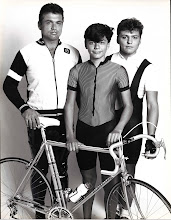As a result, Mario began working at an early age. He first served as an apprentice in a hardware store. His mechanical aptitude soon captured the attention of a family friend, Mr. Tiberghien, who gave Mario a job in his wool factory. Mario worked as a mechanic and often repaired the looms. As he grew older, he furthered his mechanical education by attending the state trade school, the Leonardo Da Vinci. Displaying his artistic side, he also made religious crosses which he sold to the Vatican.
Like most young Italian boys, Mario was captivated by bicycle racing. He was just thirteen when he joined the Aquilotti club, his town's local club. His prowess on the bike was evident due to his numerous victories. At the age of fifteen, he won the provincial championship as a junior while riding for the Gaiga club.
When he turned eighteen, the Bencini bike club invited Mario to join their ranks. The Bencini team was the best Dilettanti (semi-pro) team of that period. Local riders from Verona filled the squad's roster. The director sportif was Guido Zamperioli. From 1963 to 1966, the Bencini squad members produced impressive results:
- 1963: Gold medal, Amateur World Championships, won by Bencini rider Flaviano Vicentini
- 1964: Silver medal 100km team time trail, Tokyo Olympics with Bencini riders Pietro Guerra and Severino Andreoli
- 1965: Gold medal 100km team time trial, World Championships, Bencini squad members, Pietro Guerra and Severino Andreoli, are part of the quartet.
- 1966: Bronze medal 100km team time trail, World Championships, Pietro Guerra is a member of the quartet.
Renzo Ferrari, another teammate of Mario's from the Bencini club remembers, "I met Mario when I was 17 and he was 16. We were in a gym and we became friends even though we raced for different clubs. Mario was of good character and he got along with everyone even when he was racing. He was generous and highly esteemed for his passion of cycling. He distinguished himself from the other fellows for the attention, maintenance and care that he had for his bicycle." He adds, "Mario was always adjusting my bicycle and he even taught me how to pick wild mushrooms!"
In 1963, during a race, Renzo and Mario broke away together and rode the last 20 km together. Renzo won the race and Mario had to settle for second. However, they remained friends long after. Bencini rider and former World Champion, Pietro Guerra recalls, "Mario did not win a lot of races but he was strong, generous, and always ready to help everyone."
Pietro Guerra remembers, "When Mario stopped racing, he didn't know what to do. The passion he had for the bike was still strong so he learned right away how to build racing frames. He became a specialist in building racing frames and to make himself known in the field he gave me a track bike. It was a real jewel! With it, I won three Italian professional individual pursuit championships, 1970 at Varese, 1971 at Milano, and 1972 at Bassano del Grappa."
From 1968 to 1970, Mario continued to build frames in his home workshop. During this period, Ditta Bianchi asked him to build frames for his company under a piece work agreement. Soon, Mario had more work then he could handle by himself. He quickly outgrew his facility. In 1970, Mario hired several apprentices and was forced to relocate his frame building business. The new shop, though modest, was expansive and he lived above it in a small apartment with his parents.
His reputation continued to grow and Pietro Guerra adds, "We presented Mario to the famous Masi of Milano. In the beginning, Masi brought work to Verona for Mario. At the time the bike market was slow in Italy, so with the Masi project he transferred to California in search of better luck."
In the early seventies, the US experienced an energy crisis and a subsequent bicycle boom. Roland Sahm, a wealthy business man from San Diego contacted every Italian bicycle manufacturer on licensing their name and building frames in the US. According to Sahm, Cinelli, Colnago and Bianchi all refused him. However, one Italian bicycle manufacturer recognized the potential of the growing US market. Falierio Masi sold Sahm the rights to produce a Masi bicycle in the U.S.
Mario arrived in Los Angeles in October 12, 1973. As evidenced by the following letter he did not expect to stay long. Dated October 21, 1973, Ernesto Colnago wrote to Mario in California:
Dear Mario,
A few days ago I passed your house to say hello but I was surprised to see your mother and father a little demoralized by your leaving. They assured me that you will be back in 20 to 30 days. This pleases me because as we agreed I was going to propose a business with large profits. Come back soon and when you arrive in Milan, give me a call and I will come and get you and bring you home. Write to me.
Sincerely, Colnago



No comments:
Post a Comment